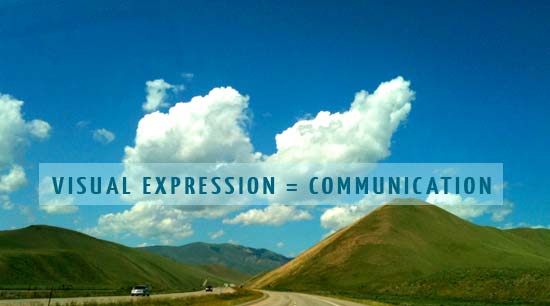Visual Communication, The Web & Social Media
Pictures Are Convincing

We’ve been waking to a changed Internet. The emphasis on text-based information for reading and exchanging ideas has expanded to visual communication and an experiential approach that relies more and more heavily on visuals and our emotional response to photographic images. Yes, it’s agreed that content is king. SEO and search engine ranking is largely built upon quality written content. But visual content is a big part of the picture, so to speak. (And that fits nicely into SEO as well just in case you’re worried.)
We no longer rely on words alone.
Ideas can be expressed and supported with visuals OR these days, some are skipping the words and jumping right on over to the visuals. Our cast of characters includes photos, graphics, infographics, charts and graphs. Our avatars identify us as authors with Google Authorship.
This isn’t really breaking news, but it’s interesting to look at certain spaces in Social Media such as Google+ and see some proof of just how far it’s gone and that it’s still going. Our Google+ Covers can tell our story and allow us to unleash our creativity. A stunning photo can say it all- or almost.
This evolution naturally includes our relationship to Social Media.
In fact, Social Media has played a big role in the shift. With the ever-increasing dominance of social media, blogs and image sites the trend toward the visual web is convincing. Posts without images are proven to get less response and shares. What? No picture? No visual re-iteration or a supporting role played by a picture make posts feel empty and dry. Expression is registered and absorbed so much more quickly through pictures and as we know, a picture is worth a thousand words.
“This is a watershed time where we are moving away from photography as a way of recording and storing a past moment,” said Robin Kelsey, a professor of photography at Harvard, and we are “turning photography into a communication medium.”
Some explanations for this trend rest on the following factors:
- Better, faster connectivity means faster load times for high resolution images especially for retina screens
- The popularity and falling costs of digital cameras and smartphone cameras has driven a renaissance in amateur photography
- Desktop computers being replaced by tablets and smartphones, which are perfect for browsing images and pictures.
- The popularity of photo sharing sites such as Flickr and Instagram which have essentially become a new entertainment media
- Photo editing and the easy availability of tools for non-professionals to create pleasing text based images
- Information overload has made people less willing to read big blocks of text especially when a picture can convey information so quickly
- The rise of Pinterest
Most industry analysts believe a key event in the rise of the visual web was the rapid growth and stunning success of the social network Pinterest. You can visit the Fat Eyes Pinterest page. Images are central to the Pinterest design and users love the site for its visual appeal. It made picture sharing easy, has simple navigation and a sensible “interest based” approach to social sharing.
Enter Social Media envy.
Yet other social media giants were envious for an unexpected reason. It turns out that this particular visual design was influencing consumer buying decisions and driving traffic to ecommerce sites. It drove twice as much traffic to e-commerce sites than Twitter which was obviously far more established, and its influence is growing. It sent more traffic to e-commerce websites in the first quarter of 2013 than it did in the holiday shopping quarter of 2012. According to the market research firm Monetate, it had the highest average order value – a whopping $80.54.- the highest among social media referrers.
“With the rapid popularity of Tumblr, Pinterest and Instagram, 2012 was a breakout year for visual content marketing. As social audiences access more and more social content through mobile devices, consumption habits trend toward succinct content with strong imagery and design.”
Is it any wonder that other social media channels, desperate for new ways to monetize their social networks, will do what they can to copy this winning approach? Many believe that the success of Pinterest forced a decision by Facebook to buy Instagram for $1 billion in cash and stock – the largest acquisition in that company’s history. They simply wanted a bigger “piece of the action” of the emerging visual web and its apparent influence over user buying decisions.
Now consider Google+
The latest attempt by Google, and by far the most serious, to enter the social networking arena. The first version of Google+ was somewhat traditional. It had decent photo sharing features, but most people saw it as basically a copy of Facebook, albeit with a superior technology. It also had Twitter-like “asymmetric following” so you didn’t need to be mutual friends with everyone to have an active stream. Basically though, it was a text stream with photo sharing included almost as an afterthought.
The first indication that Google was going “all in”: on the visual web was a release with extra large profile cover images. They could now be up to 2120 pixels by 1192 pixels with an aspect ratio” of 16×9. This takes up about 80 percent of a typical desktop screen. My initial reaction was one of disbelief. I thought it had to be a mistake -and then I acquiesced, breathed a sigh to give it a try. I wasn’t alone in thinking this was “insanely huge” but I’ve been won over by now and truly enjoy the diversity and creativity explored by users in their covers. Google+ also seemed to want to deemphasize the text descriptions on the profile – users who had written detailed business profiles found this text relegated to a narrow strip on the right size of the profile. Interestingly, it was clear that text was now considered to be less important than a “magazine” type cover photo.
The next Google+ release, however, took the visual web emphasis to an entirely new level. At the Google I/O conference in San Francisco in May, 2013 a new image-focused design that many believe resembled the Pinterest layout was announced. The company added 41 new features to Google+ that included a multi-column layout. Depending on the screen size, device and orientation there are now one, two or three columns on the user display.
Photos have taken center stage in this new layout and are resized on the fly. The new design can better accommodate different image sizes and layouts. A vertical image, for example a cartoon strip, will cause the post to be resized to fit this extra long format. At the same time, Google announced a series of features to entice users to enjoy photo sharing even more. For example, “Auto Awesome” uses a set of photos library to create an animated GIF. The smattering of these across the stream of posts creates a lively bit of action guaranteed to draw attention.
An article in the New Yorker provided some solid insights into the new visual strategy at Google: The primary interface element is what Google calls “cards,” which are modeled after real cards. “The idea is that each card is a single atomic contextual piece of information; essentially, a suggestion, a prompt, a call to action” said Matias Duarte, the lead designer of Google’s mobile operating system, Android. They are “very reserved in a way that allows the typographic and editorial images to take center stage,” he said, “the power of a card as a visual-organization metaphor, the secret of its infiltration is that “it makes very clear the atomic unity of things”
Some other indicators:
In January, 2013 Google launched the redesigned Google Images to provide a faster and more reliable image search. March 2013 brought the announcement of the imminent closing of Google Reader on July 1. Further evidence that Google is on the visual web track.
It may be too early to say “the written word is dead” and let’s hope that never comes to pass, I just can’t see how it would, thankfully, but with the industry’s most influential company taking this approach with what many believe is its most important product, it is clear that visual web has prevailed.
Photo credit: Gina Fiedel





